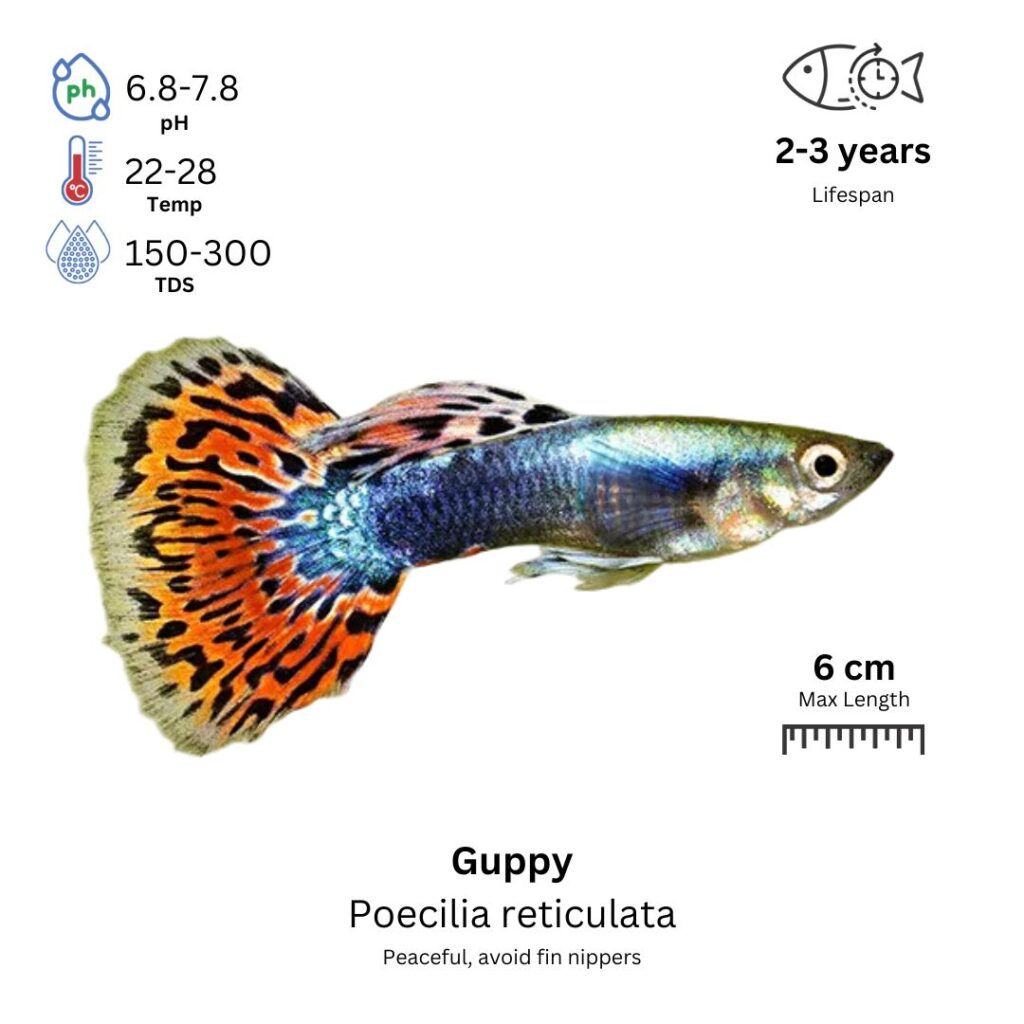Guppy
Poecilia reticulata

Description
Guppies are one of the most popular aquarium fish, known for their vibrant colors and easy care requirements. They have a small, streamlined body with long, flowing fins that can come in a variety of colors and patterns, including red, blue, yellow, green, and metallic hues. Males are typically more colorful than females and have longer fins. Female guppies are generally larger, with a more subdued color pattern. Guppies are peaceful, active, and social fish, often seen swimming in schools. They are livebearers, meaning they give birth to live young, and are known for breeding prolifically in aquariums.
Habitat Origin
Native to freshwater streams and rivers in the Caribbean, as well as parts of South America, including Venezuela, Guyana, and Trinidad. They are found in warm, slow-moving waters with dense vegetation.
Aquarium
Ideal Number in Aquarium: At least 6 individuals, as they are schooling fish and feel more secure in groups.
Favorite Food

Guppies are omnivores and will eat a variety of foods, including high-quality flake food, pellets, live or frozen foods like brine shrimp, daphnia, and bloodworms. They also enjoy plant matter, such as algae and small bits of vegetation in the tank.
Behavior:
Guppies are peaceful and active fish that do well in schools. They are non-aggressive and typically coexist peacefully with other small, non-aggressive species. Guppies are constantly on the move, swimming throughout the aquarium, especially in the middle and upper regions. They are social creatures and feel more secure in groups, often interacting with one another. Due to their small size and peaceful nature, they are ideal for community aquariums.
Special Care:
Guppies are hardy and easy to care for, making them a great choice for beginner aquarists. However, they are prolific breeders and can quickly overpopulate an aquarium if males and females are kept together without proper control. To prevent overpopulation, it is recommended to keep only males or separate males and females. Guppies also benefit from a well-planted tank with some hiding spots, especially for pregnant females looking to give birth.
Compatibility with Other Fish:
Yes, guppies are compatible with other peaceful, small fish such as tetras, rasboras, and shrimp. They should not be kept with larger or more aggressive species that may harass or eat them. Guppies are excellent for community tanks with other small, non-aggressive species. However, males may show aggressive behavior towards each other, especially in smaller tanks, so it’s best to keep one male for every two to three females to minimize aggression.
Breeding Tank Setup
Although Guppies can breed in a community tank, using a separate breeding tank is highly recommended to prevent adult fish from eating the fry and to better manage water quality. A 10-gallon tank (38 liters) is sufficient for a small group, but a 20-gallon tank (75 liters) is ideal for larger colonies. Maintain water parameters at pH 7.0–8.0, temperature 24–28°C (75–82°F), and hardness 10–20 dGH. Use a gentle sponge or internal filter to provide clean, calm water without strong currents. Fine gravel or sand substrate, along with dense plants like Java moss, Hornwort, and floating plants, gives newborn fry shelter from predation.
Conditioning for Breeding
Feed Guppies a rich, varied diet to prepare them for breeding. Offer high-quality flake or pellet food, and supplement with live or frozen foods like brine shrimp, bloodworms, and daphnia. Add vegetable matter such as finely chopped spinach or peas for a nutritional boost. Perform 20–30% weekly water changes to maintain water quality. Before breeding, a 50% water change and a slight temperature increase to 28°C can trigger reproductive behavior, mimicking natural seasonal cues.
Spawning Behavior
Guppies are livebearers, meaning they give birth to free-swimming fry. Spawning can happen at any time, often in the early morning or after a water change. Males court females by displaying vibrant colors and performing quick movements. A single female can give birth to 20–50 fry or more, depending on her size. After birthing, remove the female to prevent stress and avoid continued harassment from males. Separating adults also protects the fry from being eaten.
Fry Care & Feeding
Since Guppy fry are born live, there is no egg incubation period. Newborns are immediately mobile and must find shelter. In the first few days, feed them infusoria or liquid fry food, followed by baby brine shrimp, microworms, or finely crushed flakes. Keep the water clean and stable—perform 10–20% water changes daily or every other day, maintain consistent temperature, and avoid overfeeding to prevent water fouling. Good nutrition and pristine water are vital for strong early growth.
Breeding Notes
Guppies reach breeding maturity at 2–3 months, but for best results, wait until at least 6 months old. Males are smaller, slimmer, and more colorful, while females are larger, rounder, and paler—especially noticeable when gravid. Avoid stress by maintaining stable water conditions and keeping the tank peaceful. Good filtration, routine maintenance, and the absence of aggressive tank mates are key to successful Guppy breeding and fry survival.

